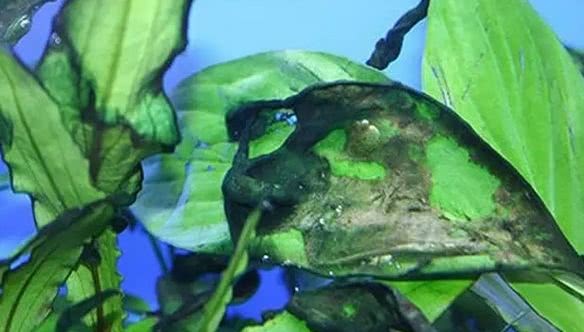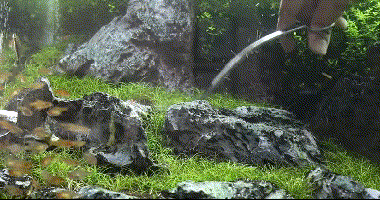Brown algae, silk algae, green spot algae, black hair algae, staghorn algae, blue algae... all go away

Cyanobacteria
Cyanobacteria are green, black and brown in color, covering the surface of the bottom sand like snot, with a foul smell, often on the interface between the bottom sand, the bottom sand and the cylinder wall.
Cause: the water quality is too hard and the bottom sand is too fine.
Treatment: use a sand washer to suck it out.
Ceratophyta cerevisiae
Staghorn algae: the shape is easily mistaken for black hair, the difference is that the black hair is like a chrysanthemum, diverging from the middle to the outside, with an obvious center, the growth of antlers is relatively irregular, and longer than black hair, similar to the antlers of a male deer.
Cause: in general, staghorn algae will appear when ammonia nitrogen exceeds the standard and PH is on the high side.
Treatment: algae leaves can be removed as far as possible, stop feeding, according to the PH value and hardness test results, increase CO2 supply and increase part of pure water when changing water.
Cercospora nigra
Black hair algae: the archenemy of the water plant tank, seriously affect the visual effect, seriously affect the growth of water plants, and extremely stubborn, because the outbreak of black hair algae cylinder is not a small number.
Features: black chrysanthemum-shaped, short and hard hair, can not be pulled with tweezers, grow on stone, sunken wood, leaves in bad condition, filter in and out of nozzle, bottom sand.
Causes: there are different opinions on the causes of the emergence of black hair algae, which are generally believed to be due to the hard water quality and high PH value, as well as the rich nutrition of water body caused by too much fish, excessive feeding and lack of frequent change of water, unreasonable composition of liquid fertilizer, imbalance of trace elements and so on.
Solution: because black hair algae is the BOSS in algae, it should be broken down on a case-by-case basis:
1. If there is black hair on the bottom sand, wash it out and throw it away.
2. Remove the black hair from the stone and brush it off with a steel wire ball
3. if you can, cut off the leaves with black hair.
4. Toothbrushes and tweezers can not remove black hair, only steel wire balls can be used.
5. Strengthen the change of water. If there are too many fish, remove some of the fish and stop feeding.
6. Check the filtration system, mainly considering the size, capacity and filter material of the filter cartridge. If black hair occurs frequently, it is recommended to increase the filtration capacity.
7. To improve the water quality, test the PH value and hardness of the water in the tank with test paper and pen, and then test the corresponding value of tap water. If the PH value is on the high side, it is recommended to increase the supply of CO2 and remove some stones. If the hardness is on the high side, it is recommended to mix it with barreled pure water of 1max 2 or 2max 3 when changing water.
8. Biological treatment: small monkey flying fox is the best choice. Fish merchants are selected to stock for about a week. Small individuals and energetic ones are put into the tank according to the situation of algae explosion. Big river algae shrimp and black shells also have some effects as conventional algae removal organisms.
Green spot algae
Green spot algae: large-leaf aquatic plants often appear, such as water banyan, etc., when the number is small, it looks like aquatic plants are malnourished.
Features: dark green speckled, often on the cylinder wall, broad-leaved negative aquatic grass leaf surface.
Cause: negative aquatic plants generally do not need too strong light, and too strong light will often lead to the emergence of green algae.
Solution: reasonably arrange the position of negative aquatic plants, try not to let the light shine directly on the leaves, the leaves with a small number of green algae can be removed with waste toothbrushes, and the large ones can be reduced directly. Next some algae eaters, elves, green moss rats, all kinds of snails.
Filamentum
Filamentous algae: this algae is also a very common kind of algae, thin green filamentous algae, very unsightly.
Features: green filamentous, can be very long, sometimes clump together to trap small fish and shrimp, often appear on the leaves of needle-like aquatic plants and Moss and at the outlet.
Cause: generally speaking, filamentous algae is considered to be a symbol of water quality stability. Excessive light, excessive liquid fertilizer and poor condition of aquatic plants are the main causes.
Treatment method: first of all, it is suggested that the physical cleaning method should be used to roll the waste toothbrush along the direction of the filamentous algae until the toothbrush will pick up the leaves; secondly, the light time will be reduced by 1-2 hours, and the liquid fertilizer will be halved. After the filamentous algae disappears, the light time will not change. Gradually increase the liquid fertilizer to the standard dosage.
If the filamentous algae are repeated, reduce the standard amount of liquid fertilizer.
Brown algae
Brown algae: one of the more common algae in grass tanks, usually in the initial stage of cylinder construction.
Features: yellow-brown mottled, appearing on stones, cylinder walls, sunken wood, leaves.
Cause: generally brown algae is considered to be an imperfect sign of the establishment of nitrification system, if in the early stage of tank construction, the aquatic plants have not yet adapted to the water quality, and the nitrification system has not been established, the so-called tank-breaking fish is placed early, then the excess ammonia nitrogen brought by these fish can not be disposed of by the nitrification system in time, then it will lead to the eutrophication of the water body, and then brown algae and fish and shrimp will often break out and die inexplicably.
The solution: first of all, speed up the establishment of nitrification system, put nitrifying bacteria capsules or nitrifying bacteria solution after each change of water; secondly, add grass shrimp 2 weeks after construction, and fish 3 weeks later, the number of fish gradually adapt to the water body from less to more. Third, if the outbreak of brown algae affects the development of aquatic plants, it is best to remove them manually, remove the stones and sunken wood covered with brown algae, scrub them with steel balls and then enter the tank.
Control of all kinds of algae in water grass tank
The key to algae control is that the growth of aquatic plants and algae need the same nutrients, grass algae inhibition, appropriate light, PH value, hardness, CO2, fertilizer, nitrification system, regular change of water, not only the state of grass can be good, but also algae can be well inhibited. As for what kind of lighting, PH and so on is appropriate, only careful observation, appropriate adjustment and summary every day, can we master the living habits of aquatic plants in their own tanks and raise perfect aquatic plants.
There are surprises here.
- Prev

The seasonal characteristics and health-keeping methods that should be known for a good autumn and March.
"Autumn March, this is called Rong Ping. The weather is urgent and the weather is bright. Early to bed and early to rise makes you happy with the chicken. Make peace of mind and reprieve the autumn sentence. Restrain the air and flatten the autumn spirit. With no exception to its ambition, to clear the lungs-this autumn should be the way to nourish the harvest. " -.
- Next

Matters needing attention in pruning aquatic plants
1. When pruning, it is best to turn off the foreground grass such as cow hair, mini short, dwarf pearl, which is less dense than water. During pruning, there will be a lot of debris floating on the water surface, which is likely to come from the floats and teeth of the oil remover.
Related
- Wuhan Hospital Iron Tree Blooming Result Was Instantly Frightened by the Gardener Master
- Which variety of camellia is the most fragrant and best? Which one do you like best?
- What is the small blue coat, the breeding methods and matters needing attention of the succulent plant
- Dormancy time and maintenance management of succulent plants during dormancy
- Minas succulent how to raise, Minas succulent plant pictures
- What are the varieties of winter succulent plants
- How to raise succulent plants in twelve rolls? let's take a look at some experience of breeding twelve rolls.
- Attention should be paid to water control for succulent plants during dormant period (winter and summer)
- Watering experience of twelve rolls of succulent plants
- Techniques for fertilizing succulent plants. An article will let you know how to fertilize succulent plants.

